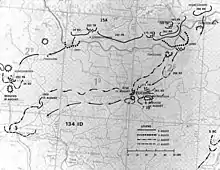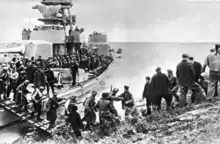34th Rifle Division (Soviet Union)
The 34th Rifle Division (Russian: 34-я стрелковая дивизия) was an infantry division of the Red Army during and before World War II. The division was formed in 1923. It fought in the Soviet invasion of Manchuria in August 1945. Postwar, it became the 11th Machine Gun Artillery Division.
| 34th Rifle Division | |
|---|---|
| Active | 1923–1948 |
| Country | Soviet Union |
| Branch | Red Army |
| Type | Infantry |
| Garrison/HQ | Samara (as territorial division) |
| Engagements | Soviet invasion of Manchuria |
| Decorations | |
| Honorifics | Middle Volga Named for Valerian Kuybyshev |
History
Before 1941
The 34th was originally formed as a territorial division of the Volga Military District in accordance with orders of 14 and 23 September 1923, from the cadre of the mobilization unit colocated with the 33rd Samara Rifle Division.[1] Headquartered at Samara, the division included the 100th, 101st, and 102nd Rifle Regiments, stationed at Ufa, Syzran, and Samara, respectively, in addition to light artillery and howitzer battalions and sapper and communications companies. Its anniversary was celebrated on 8 November. The artillery units of the division were merged to form the 34th Artillery Regiment on 20 October 1924. As a territorial unit, the permanent cadre of the division conducted pre-conscription training camps in the northern hemisphere winter, three-month summer training camps for new conscripts, and fifteen-day combined arms training camps for older conscripts every year since 1924. The conscripts assigned to the 34th were drawn from Samara Governorate.[2]
It was given the honorific Middle Volga on 10 July 1930. In March 1934, it attained Cadre status and was transferred to Far East, joining the Special Red Banner Far Eastern Army (OKDVA) in April. On 10 June 1935, it received the honorific named for Valerian Kuybyshev. At this point it was assigned to the 18th Rifle Corps of the OKDVA with its headquarters and 102nd Rifle Regiment at Birobidzhan, while the 100th Rifle Regiment and 34th Artillery Regiment were at Babstovo and the 101st Syzran Rifle Regiment was at Novy.[3] On 1 July 1938 the OKDVA was broken up and the division became part of the 2nd Army, which became the 2nd Red Banner Army on 4 September of that year. On 1 July 1940 it became part of the newly formed 15th Army when the 2nd Red Banner Army was split.[1]
Garrison duty in the Far East
It was part of the 15th Army and the 18th Rifle Corps on 22 June 1941.[4] 260th Rifle Brigade commander Colonel Ignat Vetvitsky became acting division commander in late April, and turned over command to Colonel Stepan Kolomiets, a recent graduate of a course at the Higher Military Academy, in mid-December 1943.[5] Kolomiets was promoted to major general on 13 September 1944, but was relieved of command on 16 July 1945 for "indecisiveness in restoring discipline to units of the division."[6] He was replaced by 3rd Rifle Division commander Major General Pavel Dyomin, who led the division during the Soviet invasion of Manchuria.[7]
Soviet invasion of Manchuria

In the Soviet invasion of Manchuria, the division participated in the attack across the Amur River conducted by the 2nd Far Eastern Front, known in Soviet historiography as the Sungari Offensive. The 15th Army was tasked with making the main attack of the front with its three forward rifle divisions: the 34th, 361st and 388th.[8] With the 203rd Tank Brigade, the 34th was positioned near Blagoslovennoye, tasked with launching the rightmost of the three attacks of the 15th Army. The 34th and the 203rd Tank Brigade were to cross the Amur, capturing Luobei and the Japanese Xingshanzhen fortified region before linking up with the 361st and 388th Divisions at Jiamusi on the Sungari River. The Soviet forces faced the Japanese 14th Border Guards Unit at Xingshanzhen and the 134th Infantry Division at Jiamusi.[9]

Operations began at 01:00 on 9 August, when the divisions of the 15th Army sent reconnaissance detachments and advanced battalions to capture major islands in the Amur. These were captured and in the predawn hours, reconnaissance parties crossed to the southern bank of the river. During the day positions on the islands and on the southern bank were consolidated, as main forces concentrated to cross the Amur in force. The operations were hindered by heavy rains, high water, and mud. On the night of 9–10 August, the divisions of the 15th Army conducted reconnaissance-in-force on Japanese strongpoints on the south bank, and late on 10 August an advanced regiment from the 34th captured the village of Lopei, reconnoitering strongpoints to the south.[10]
The main force of the division and the 203rd Tank Brigade crossed the river at Lopei around this time, and advanced to the south after bypassing the Xingshanzhen fortified region, leaving a small detachment behind to reduce it. The fortified region fell within three days after artillery bombardment and airstrikes forced the Japanese to retreat either towards Jiamusi or the mountains west of Xingshanzhen.[11] The advance of the division towards Jiamusi was stymied by formidable Japanese opposition south of Xingshanzhen, which was outflanked by a 14 August amphibious landing of the 83rd Rifle Regiment of the 34th and another regiment from the 361st Division by ships of the Amur Flotilla near Huachuan on the Sungari, 40 kilometers (25 mi) north of Jiamusi. This movement forced the Japanese defenders to retreat to Jiamusi. The latter was captured by the 361st and 388th on 17 August, after which the 15th Army continued to pursue the retreating Japanese until 21 August.[12]
Postwar
It became part of the 5th Rifle Corps from 3 September 1945. For its combat service,[13] it was awarded the Order of the Red Banner on 14 September 1945.[14] In the fall of 1945, the division became part of the Transbaikal-Amur Military District at Vyazemsky.[15] The division was transferred to the Far Eastern Military District and was commanded by Dyomin until around March 1947.[7] It became the 11th Machine Gun Artillery Division in 1948.[16]
Commanders
The following officers commanded the division.[13]
- Semyon Avvakumovich Spilnichenko (1925)
- Mikhail Khozin (1926–1932)
- Komdiv Vilyam Rokhi (1932–1937) - arrested and shot during the Great Purge
- Colonel Alexey Ivanovich Prilepsky (26 March 1941 – 7 February 1942)[17]
- Major General Nikolai Alekseevich Kichaev (8 February 1942 – 27 April 1943)[17]
- Colonel Ignat Vetvitsky (28 April–14 December 1943)[17]
- Colonel Stepan Kolomiets (15 December 1943 – 16 July 1945; promoted to Major General 13 September 1944)[17][6]
- Major General Pavel Dyomin (July 1945 – c. March 1947)[7]
Composition
The division included the following units during World War II.[18]
- 83rd Rifle Regiment
- 134th Rifle Regiment
- 327th Rifle Regiment
- 63rd Artillery Regiment
- 145th Howitzer Artillery Regiment
- 75th Separate Antitank Artillery Battalion
- 478th Separate Antiaircraft Artillery Battalion
- 7th Reconnaissance Company
- 59th Sapper Battalion
- 89th Separate Signals Battalion
- 12th Medical Battalion
- 14th Separate Chemical Defense Company
- 9th Repair and Reconstruction Company
- 58th Auto Transport Company
- 102nd Field Bakery
- 62nd Divisional Artillery Workshop Battalion
- 33rd Field Mobile Hospital
- 217th Veterinary Field Hospital
- 69th Field Postal Station
- 265th Field Cash Office of the State Bank
References
Citations
- Dvoinykh, Kariaeva & Stegantsev 1993, pp. 117, 446–447.
- History of the 34th Rifle Division 1947, p. 1.
- Red Army Station List, 1 July 1935, pp. 28–29.
- "34-я Средне-Волжская Краснознаменная стрелковая дивизия им. В. Куйбышева" [34th Middle Volga Red Star Rifle Division in the name of V. Kuybyshev]. rkka.ru (in Russian). Retrieved 26 February 2016.
- Tsapayev & Goremykin 2014, p. 451.
- Tsapayev & Goremykin 2015, p. 313.
- Tsapayev & Goremykin 2014, p. 814.
- Glantz 2003, p. 262.
- Glantz 2003, p. 263.
- Glantz 2003, p. 265.
- Glantz 2003, p. 267.
- Glantz 2003, pp. 268–269.
- "34-я Средне-Волжская Краснознаменная стрелковая дивизия им. В. Куйбышева" [34th Middle Volga Red Star Rifle Division in the name of V. Kuybyshev]. samsv.narod.ru (in Russian). Archived from the original on 2016-03-04. Retrieved 2015-09-06.
- Affairs Directorate of the Ministry of Defense of the Soviet Union 1967, p. 417.
- Feskov et al. 2013, p. 579.
- Feskov et al. 2013, p. 581.
- Main Personnel Directorate of the Ministry of Defense of the Soviet Union 1964, p. 118.
- Avanzini, Michael; Crofoot, Craig (2004-10-01). Armies of the Bear. Tiger Lily Publications LLC. ISBN 9780972029629.
Bibliography
- Affairs Directorate of the Ministry of Defense of the Soviet Union (1967). Сборник приказов РВСР, РВС СССР, НКО и Указов Президиума Верховного Совета СССР о награждении орденами СССР частей, соединениий и учреждений ВС СССР. Часть II. 1945 - 1966 гг [Collection of orders of the RVSR, RVS USSR and NKO on awarding orders to units, formations and establishments of the Armed Forces of the USSR. Part II. 1945–1966] (in Russian). Moscow.
- "Дислокация войсковых частей, штабов, управлений, учреждений и заведений Рабоче-Крестьянской Красной Армии по состоянию на 1 июля 1935 года" [Stationing of military units, headquarters, directorates, institutions and establishments of the Red Army as of 1 July 1935] (PDF) (in Russian). Moscow: 4th Directorate of the Staff of the Red Army. 1 July 1935.
- Dvoinykh, L.V.; Kariaeva, T.F.; Stegantsev, M.V., eds. (1993). Центральный государственный архив Советской армии: Путеводитель [A Guide to the Central State Archive of the Soviet Army] (in Russian). 2. Minneapolis: Eastview Publications. ISBN 1879944030. Archived from the original on 30 August 2017.
- Feskov, V.I.; Golikov, V.I.; Kalashnikov, K.A.; Slugin, S.A. (2013). Вооруженные силы СССР после Второй Мировой войны: от Красной Армии к Советской [The Armed Forces of the USSR after World War II: From the Red Army to the Soviet: Part 1 Land Forces] (in Russian). Tomsk: Scientific and Technical Literature Publishing. ISBN 9785895035306.
- Glantz, David M. (2003). The Soviet Strategic Offensive in Manchuria, 1945: August Storm. London: Frank Cass. ISBN 0-7146-5279-2 – via Questia.
- "История 34 сд" [History of the 34th Rifle Division]. Pamyat Naroda (in Russian). Central Archives of the Russian Ministry of Defence. 1947. Retrieved 10 September 2019. – Written by division staff officers, located in fond 1121, opus 1, file 4 of the Central Archives of the Russian Ministry of Defence
- Main Personnel Directorate of the Ministry of Defense of the Soviet Union (1964). Командование корпусного и дивизионного звена советских вооруженных сил периода Великой Отечественной войны 1941–1945 гг [Commanders of Corps and Divisions in the Great Patriotic War, 1941–1945] (in Russian). Moscow: Frunze Military Academy.
- Tsapayev, D.A.; et al. (2014). Великая Отечественная: Комдивы. Военный биографический словарь [The Great Patriotic War: Division Commanders. Military Biographical Dictionary] (in Russian). 3. Moscow: Kuchkovo Pole. ISBN 978-5-9950-0382-3.
- Tsapayev, D.A.; et al. (2015). Великая Отечественная: Комдивы. Военный биографический словарь [The Great Patriotic War: Division Commanders. Military Biographical Dictionary] (in Russian). 4. Moscow: Kuchkovo Pole. ISBN 978-5-9950-0602-2.